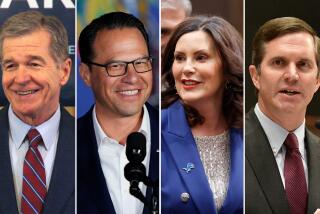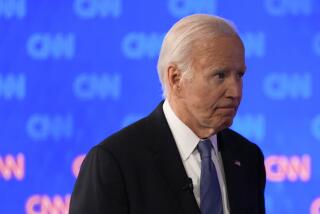Key Legislators Vow ‘Giant Step’ for Tax Reform : Will Collaborate on Bill to Cut Rates, Eliminate Most Deductions and Credits
In a rare bipartisan appeal, key Democratic and Republican legislators Wednesday opened a campaign for tax reform, with Rep. Richard A. Gephardt (D-Mo.) declaring: “1985 is the year to take a giant and necessary step to revamp the antiquated tax code.”
Speaking for the Republicans, Rep. Jack Kemp of New York said at a joint news conference that President Reagan is “deeply committed “ to tax reform. The President will have “an opportunity unmatched in this century” to spur economic growth through a simplified tax system, Kemp said.
Gephardt and Democratic Sen. Bill Bradley of New Jersey pledged at the news conference to collaborate with Kemp and Republican Sen. Bob Kasten of Wisconsin in preparing legislation that would reduce tax rates and eliminate most deductions and credits.
New Bipartisan Plan
An hour later, another bipartisan plan, calling for a flat tax rate of 19%, was introduced at a news conference by Sens. Dennis DeConcini (D-Ariz.) and Steven D. Symms (R-Ida.). Their proposal--which would wipe out all deductions except personal allowances for the taxpayer, spouse and dependents--would lead to a simple 12-line tax return that could be filed on a post card.
“At five minutes before midnight on April 15, you’ve got plenty of time to fill out your own tax card,” said Prof. Alvin Rabushka of Stanford University’s Hoover Institution, who devised the plan along with one of his colleagues, economist Robert Hall.
According to Kasten, a system of lower tax rates would offer savings to about 70% of all Americans--those who do not claim any itemized deductions on their tax returns. The current tax code has rates ranging up to 50% for personal income but all of the bipartisan proposals, as well as the Treasury Department plan announced in November, would slash the top individual rate. Under the Treasury plan, the rate would fall to 35%; Bradley-Gephardt, 30%; Kemp-Kasten, 24%, and DeConcini-Symms, 19%.
Because Reagan’s pledge against a tax increase was a key part of his successful reelection campaign, the political climate makes it virtually impossible to advocate higher taxes. Thus, all of the reform plans are “revenue neutral” and would maintain total tax collections at current levels.
But there would be dramatic shifts in the tax burden for particular families or individuals or corporations, depending on which plan is adopted. Generally speaking, individuals and families would pay less and businesses would pay more. Likewise, those who now make extensive use of tax deductions and credits would pay more, while those with simple tax returns would pay less.
“If the President is truly willing to take on the special interests to give the American people lower taxes . . . there is a real opportunity to get it done this year,” Bradley said.
Bradley brushed aside questions on the differences between his program and the version offered by Kemp, which would preserve more corporate tax deductions. Instead, Bradley, Kemp, Gephardt and Kasten repeatedly proclaimed their devotion to key principles: lower tax rates and elimination of deductions.
Details can be settled later, Kasten noted, saying: “There is nothing in our bill that isn’t negotiable.” Gephardt agreed, declaring: “The issue is bipartisan. Our effort today is to forge that coalition.”
More to Read
Get the L.A. Times Politics newsletter
Deeply reported insights into legislation, politics and policy from Sacramento, Washington and beyond. In your inbox three times per week.
You may occasionally receive promotional content from the Los Angeles Times.






